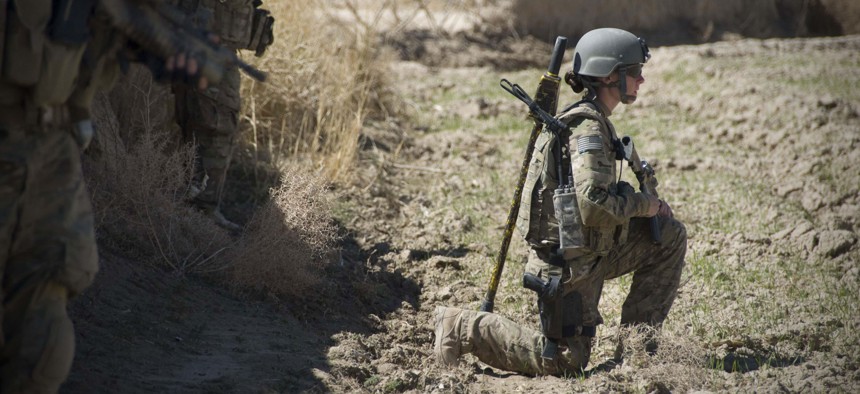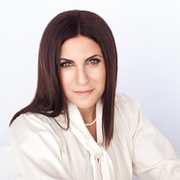
A U.S. Cultural Support Team service member, assigned to Special Operations Task Force – South, keeps an eye out for threats during a security patrol March 9, in Panjwai District, Kandahar province, Afghanistan. U.S. Army photo by Sgt. Ben Watson
Where Are Pop Culture’s Women Warriors?
Hollywood leaves female troops off its made-up battlefields — and that matters to audiences and vets themselves.
Over the past decade, a string of war movies emerged in the wake of 9/11: The Hurt Locker, Syriana, The Messenger, Green Zone, Lone Survivor, and American Sniper, to name just a few. Some have performed better than others at the box office, and many have received critical acclaim. Almost none has included portrayals of women in combat.
For the last two years I reported on a team of women soldiers recruited by special operations in 2011 to serve on combat missions alongside Army Rangers and Navy SEALs, among other special operations teams, all while the combat ban on women remained in place. When I would tell friends I was working on a story about a “band of sisters” on the front lines—women connected forever by what they saw and did at war and by the fact that America had no idea they did it—they would ask me if the story was about rape or PTSD.
Neither, I would answer. The story was about valor.
I realized by the third time I heard the question that it kept resurfacing in part because the victim narrative has overtaken all others in recent years when it comes to the story of women in uniform. There have been precious few depictions of women in uniform doing their actual jobs, most noticeably when it comes to the movies. Among the recent spate of war films, hardly any women are seen as service members central to the action. In Afghanistan, women in uniform are widely seen in the airports and across bases heading to work. But watch a war movie and the roughly 300,000 women who have deployed in America’s post-9/11 wars are largely missing in action.
These untold stories have consequences both for how America sees its women in uniform and how they see themselves: With women mostly absent from our war stories, Americans find it hard to understand the combat their servicewomen have seen. And the women themselves are loath to explain their experience to a nation that already struggles to connect with the less than one percent of the country that has fought its wars.
(See also: Two Women Advance To Final Phase of Army Ranger School)
Historically, war films have offered snapshots of how people have perceived the military in different eras, as well as a path to reckoning with what we ask of our young men in uniform. “There haven’t been that many post-9/11 war movies, let alone good ones, and most of those have focused on parts of the military that are almost exclusively male,” says Phil Carter, an Iraq war veteran and the director of the Military, Veterans, and Society Program at the Center for a New American Security.
Carter points specifically to the special operations stories Lone Survivor and American Sniper, both of which did big business at the box office. Particularly in the wake of the successful raid on the Osama bin Laden compound in 2011, Navy SEAL stories have captured the American imagination. As of today women still remain barred from becoming SEALs and Army Rangers in their own right, which explains much of why they are absent from these stories. Still, they’ve played important roles in the special operations community for years, including serving as the Explosive Ordnance Disposal Technicians featured in The Hurt Locker.
While women have been going to war in greater numbers than ever before in the decades since 9/11, their stories have yet to catch up with their service. Two female servicemembers have received the Silver Star. More have received the Bronze Star Medal, along with Purple Hearts and countless Combat Action Badges. Women have broken ground as pilots, military police, intelligence officers and, to a lesser-known extent, inside elite special operations units—all on the front lines and primarily while they were officially banned from ground combat.
(Read more: How One Woman Earned Her Way Onto the Special Ops Battlefield)
But on the big screen, there’s a decided absence of valor when it comes to women in uniform. This has implications because it means the hero war story—and the antihero war story—doesn’t include women.
“In the majority of both movies and TV shows there’s a real dearth of military women, and when they do exist they’re often portrayed as victims of sexual assault,” says the Iraq veteran and author Kayla Williams. “That definitely contributed to my feelings of isolation and alienation when I came home. Not seeing myself represented alongside the people I served with added to civilians not understanding that women are there, because they are responding in large part to the portrayals they see in pop culture. When they don’t see any women, it makes it easy to assume we’re not there or that we play these really limited roles.”
How do you have a homecoming or approach to offer a “thank you for your service” to someone whose deployment isn’t acknowledged or observed, let alone celebrated? Or as the novelist and author Cara Hoffman wrote in 2013 in The New York Times, “I can’t help but think women soldiers would be afforded the respect they deserve if their experiences were reflected in literature, film and art—if people could see their struggles, their resilience, their grief represented.”
This isn’t to say that women are absent from all portrayals of films focused on the War on Terror and America’s role in fighting al-Qaeda. In both Zero Dark Thirty, which chronicles the hunt for Osama bin Laden and is best known for the controversy regarding the veracity of the torture scenes included, and Fair Game, the story of the outed former CIA agent Valerie Plame and her fight to regain her name and reputation after her occupation was exposed, women were the primary characters. Those films showed the women who served at the center of America’s battle against terrorism in ways that illuminated the complexity of their work. And both contributed to the popularization of the “female CIA analyst/agent” narratives that remain very much a part of today’s media moment. Both were based on true stories.
Yet for the most memorable portrayals of women in action, wearing a uniform for her nation in wartime, you have to go back to the 1990s, and to fiction.
In Starship Troopers, Denise Richards plays a pilot in a world where women serve in the Mobile Infantry and train, deploy—and hit the showers—alongside men. In Courage Under Fire, Meg Ryan plays a rescue helicopter pilot killed in Iraq. The central question of the film is whether or not she should posthumously receive the Medal of Honor. In G.I. Jane, Demi Moore plays an intelligence officer who refuses to quit after she’s given a shot at becoming a Navy SEAL.
Perhaps it was because these movies were made at a relatively peaceful moment in America’s pre-9/11 history that they feature women. They also could dance around the pressing questions of women in combat without having to wrestle with real life-and-death situations and the issue of how, exactly, America feels about having women on the front lines. But whether culture has caught up or not, women already are fighting America’s wars.
(See also: As Deadline Nears, Special Ops Chiefs Talk Women In Combat)
“Reality has outpaced perception in terms of what people think that women are out there doing,” says Janine Davidson, a former Pentagon official, Air Force veteran, and one of the first women to fly C-130s. “Movies are what I think will help the American people and the audience to be able to really recognize and understand what women bring to the fight and that women can do this.” Davidson says that more war stories on the big screen featuring the real-life feats of women—and men—on the battlefield would help show America that women have been at war and seeing combat first-hand for years. They would also help those women after they return home.
“One of the things I’ve started to ponder is whether women’s reluctance to self-identify as veterans is partly linked to this absence,” Williams says. Across America, veterans’ service providers and non-profits seeking to offer services to female veterans say that they have to ask women specifically whether they’ve served because so few volunteer the information. One North Carolina non-profit actually began asking its clients directly whether they’d ever been part of the military because so few had self-identified as veterans.
How we see women in uniform matters both to them and to us. At a time when so few Americans serve, movies often comprise the only exposure many get to combat, and shape the way we see who fights the nation’s battles. “For the American public, these movies are the reality of war,” Carter says. “Most Americans didn’t go to Vietnam—their Vietnam was Platoon and Full Metal Jacket and Apocalypse Now. And more than 99 percent of Americans did not go to Iraq and Afghanistan, so their reality is Zero Dark Thirty and American Sniper.”
It’s possible a shift is on the horizon. In the wake of American Sniper’s box-office success and the fact that unconventional women-driven films are on the rise (as evidenced by the success of Spy and Mad Max: Fury Road) there seems to be an increasing appetite for fictional stories in which women are heroes. Now comes the test of whether they can be real-life heroes as well.
Since March, three books about women in war have been picked up by Hollywood. TriStar pictures purchased the film rights to Shoot Like a Girl: How One Woman’s War Against the Taliban Led to Her Victory Over the Department of Defense, an upcoming memoir by Air Force Major Mary Jennings Hegar. Warner Brothers bought the war photographer Lynsey Addario's memoir It’s What I Do: A Photographer’s Life of Love and War. And Fox 2000 won the rights to Ashley’s War, the book I had the privilege of writing about a team of women recruited to serve alongside Army Rangers, Navy SEALs, and other special operations units on combat missions in 2011.
As Adam Green wrote in the May issue of Vogue about Grounded, a play starring Anne Hathaway as a drone pilot, “Females in the line of fire now seem to be having a moment.” Of course, how Hollywood depicts women on the battlefield will be as important as the question of whether they are seen at all.
“Whether the upcoming movies featuring women in war will broaden the public's perception has everything to do with how those women are portrayed,” says Helen Benedict, the author of two book about women and war and a professor at Columbia University. “If these films push women into the stereotypes of the past—women who wimp out and need rescuing or who are nothing but a [love] interest—that won't help at all.”
But if these real-life warriors receive three-dimensional treatment, perhaps a new spate of war stories could help pry open the American definition of the hero to include more women—both fictional and real.
“It will make the biggest difference to young men and women who look to the movies for inspiration,” Carter says. “My daughter will grow up seeing these stories and hearing these stories from me and my wife, and know that she can do anything she wants.”
NEXT STORY: America's Allies Want More From the US




